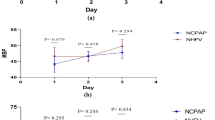Abstract
Indomethacin has proven effective in closing the patent ductus arteriosus (PDA) in most low birth weight (LBW) neonates with this disorder. Early reopening of the ductus is a problem and often leads to the need for surgery. Prolonged use of indomethacin for several days has been suggested as a means to alleviate this problem. The present study was designed to determine if prolonged therapy over 5 days is more effective than a two-dose regimen in preventing reopening of the PDA. Seventy neonates were randomized for either prolonged therapy over 1 week or to receive two doses of indomethacin. All infants were given two doses of indomethacin 0.15 mg per kg, 12 h apart. The maintenance group received an additional 0.1 mg per kg daily for 5 days. Ten days after the infants' initial dose of indomethacin, 6 of 22 in the nonmaintenance group as compared to 0 of 22 in the maintenance group had reopening of their ductus arteriosus. Ten infants in the maintenance group eventually had the ductus reopen at a median of 29, range 11–66 days compared to a median of 3, range 2–44 days in the nonmaintenance group. Significantly fewer babies in the maintenance group had a grade II–IV intraventricular hemorrhage compared to the nonmaintenance group. There was no other significant difference in the two groups in the incidence of necrotizing enterocolitis, retrolental fibroplasia or death. Indomethacin given over 5 days is effective for closure of the ductus arteriosus and will prevent reopening until after the acute clinical course in babies under 1500 g; however, the overall incidence of reopening was not different.
Similar content being viewed by others
Abbreviations
- HMD:
-
hyaline membrane disease
- IVH:
-
intraventricular hemorrhage
- NICU:
-
neonatal intensive care unit
- NIH:
-
National Institutes of Health
- PDA:
-
patent ductus arteriosus
- LBW:
-
low birht weight
- VLBW:
-
very low birth weight (less than 1500 g)
References
Dougherry JH, Levy DE, Rawlinson DG, Ruff R, Weksler BB, Plum F (1982) Experimental cerebral ischemia produced by extracranial vascular injury: Protection with indomethacin and prostacyclin. Neurology 32:970–974
Gersony WM, Peckham GJ, Ellison RC, Miettinen OS, Nadas AS (1983) Effects of indomethacin in premature infants with patent ductus arteriosus: results of a national collaborative study. J Pediatr 102:895–906
Harris RJ, Bayhan M, Branston NM, Watson A, Symon L (1982) Modulation of the pathophysiology of primate focal cerebral ischaemia by indomethacin. Stroke 13:17–24
Hallenbeck JM, Furlow TW (1981) Prostaglandin 12 and indomethacin prevent impairment of post-ischemic brain perfusion in the dog. Stroke 10:629–637
Johansson BB (1981) Indomethacin and cerebrovascular permeability to albumin in acute hypertension and cerebral embolism in the rat. Exp Brain Res 42:331–336
Kontos HA, Wei EP, Povlishock JT, Dietrich WD, Magiera CJ (1980) Induction of endothelial lesions in pial arterioles by arachidonic acid and prostaglandin G2. Stroke 11:129 (abstr)
Leonhardt A, Isken V, Kuhl PG, Seyberth HW (1987) Prolonged indomethacin treatment in preterm infants with symptomatic patent ductus arteriosus: efficacy, drug level monitoring, and patient selection. Eur J Pediatr 146:140–144
Lipman B, Serwer GA, Brazy JE (1982) Abnormal cerebral hemodynamics in preterm infants with patent ductus arteriosus. Pediatrics 69:778–781
Maher P, Lane B, Ballard R, Piechch R, Clyman RI (1985) Does indomethacin cause extension of intracranial hemorrhages: a preliminary study. Pediatrics 75:497–499
Mahony L, Carnero V, Brett C, Heymann MA, Clyman RI (1982) Prophylactic indomethacin therapy for patent ductus arteriosus in very-low-birth-weight infants. N Engl J Med 306:506–510
Martin CG, Snider AR, Katz SM, Peabody JL, Brady JP (1982) Abnormal cerebral blood flow patterns in preterm infants with a large patent ductus arteriosus. J Pediatr 101:587–593
Ment LR, Stewart WB, Duncan CC, Scott DT, Lambrecht R (1983) Beagle puppy model of intraventricular hemorrhage: effect of indomethacin on cerebral blood flow. J Neurosurg 58:857–862
Ment LR, Stewart WB, Scott DT, Duncan CC (1983) Beagle puppy model of intraventricular hemorrhage: randomized indomethacin prevention trial. Neurology 33:179–184
Ment LR, Duncan CC, Ehrenkranz RA, Kleinman CS, Pitt BR, Taylor KJ, Scott DT, Stewart WB (1985) Randomized indomethacin trial for prevention of intraventricular hemorrhage in very low birth weight infants. J Pediatr 107:937–943
Papile L, Burstein J, Burstein R (1978) Incidence and evolution of subpendymal and intraventricular hemorrhage: a study of infants with birthweight less than 1500 grams. J Pediatr 92:529–534
Perlman JM, Hill A, Volpe JJ (1981) The effect of patent ductus arteriosus velocity in the anterior cerebral arteries: ductal steal in the premature newborn infant. J Pediatr 99:767–771
Pickard JD, Mackenzie ET (1973) Inhibition of prostaglandin synthesis and the response of baboon cerebral circulation to carbon dioxide. Nature New Biol 245:187–188
Setzer ES, Morse BM, Goldberg RN, Smith M, Bancalari E (1984) Prophylactic indomethacin and intraventricular hemorrhage (IVH) in the premature infant. Pediatr Res 18:345 (abstr)
Seyberth HW, Rascher W, Hackenthal R, Wille L (1983) Effects of prolonged indomethacin therapy on renal function and selected vasoactive hormones in very-low-birth-weight infants with symptomatic patent ductus arteriosus. J Pediatr 103:979–984
Zednikova M, Baylen BG, Yoshida Y, Emmanouilides GC (1982) Precordial contrast echocardiographic detection of patent ductus arteriosus in small preterm infants. Pediatr Cardiol 2:271–275
Author information
Authors and Affiliations
Rights and permissions
About this article
Cite this article
Rhodes, P.G., Ferguson, M.G., Reddy, N.S. et al. Effects of prolonged versus acute indomethacin therapy in very low birth-weight infants with patent ductus arteriosus. Eur J Pediatr 147, 481–484 (1988). https://doi.org/10.1007/BF00441971
Received:
Accepted:
Issue Date:
DOI: https://doi.org/10.1007/BF00441971




